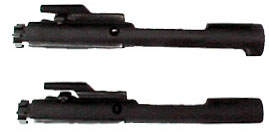|
At the request of several of our customers, and questions fielded by our sales staff, we have added this page to our web site to assist our customers in the identification of a bolt carrier as being one of a semi-auto, or full-auto design. The following information should clear this up for you. If after reading this, you still have questions, please feel free to email us with those questions or comments.
|
|
This is a full-auto bolt carrier assembly. Notice that the rear of the bolt carrier reenforcements (both top and bottom) are of equal length. For a bolt carrier to be considered "full-auto", the lug on the underside of the carrier MUST be the SAME LENGTH as the top portion of the rear of the carrier. |
|
|
|
These are both semi-auto bolt carriers. Notice that the under-lugs of the bolt carriers are shorter (on the top carrier to the left), and completely missing on the other (bottom left) bolt carrier (Only Colt's® manufacturing makes their bolt carriers in such a manner).
For a bolt carrier to be considered a "semi-auto" -vs- a "full-auto" model, the underlug (the portion that is used to trip the auto sear of a fully-automatic machine gun M16) must be milled back only a short amount. A quarter of an inch is plenty.
|
|
|
This view shows all three underlugs side by side for comparison. On the far left is the full-auto carrier. It's underlug is of equal length as the cover (the upper portion of the rear of the bolt carrier) of the back portion of the bolt carrier as seen in the top photo. The forward or leading edge of this underlug is what trips the full-auto sear of the fully automatic M16 machine gun at the precise moment required to fire the M16 in a fully-automatic mode. Without the critical location of this underlug, as well as the cooperation of other associated fully-automatic fire control components, the M16 is not capable of firing full-auto. |
Timing is ultra-critical with regards to full-auto fire of any machine gun. Without the critical location of the forward edge of the M16's bolt carrier underlug (one eighth of an inch is enough to create the difference in timing required prevent full-auto fire), the timing would be off , and the weapon would not function as a machine gun. By simply trimming back this front edge of the underlug, a full-auto carrier can be made into a semi-auto carrier in seconds on any bench grinder.
The length of this underlug is the only critical dimension or feature that determines whether or not a bolt carrier is a full-auto part or not.
Although a fully covered firing pin area on the bottom of a bolt carrier assembly is a "full-auto feature", it has no bearing what so ever as to whether a carrier is a full-auto model or not. On a technical note, the mil-spec variance for a full-auto carrier's underlug is only +/- .0005". Anything more than this does not qualify as a mil-spec full-auto carrier.
|
|
|
Notice the red lines indicating the lengths of the underlugs in each photo.
|
These bolt carriers are manufactured by Olympic Arms. To comply with regulations the underlug of our semi-auto bolt carriers are milled back roughly 1/3 of an inch. This is enough to make the carrier semi-auto only, yet considerably more than is required to make it a non-full auto carrier. Cut to this length, the underlug will not trip an auto sear at the proper time to allow for for fully automatic fire, but still maintains maximum strength and rigidity. |

